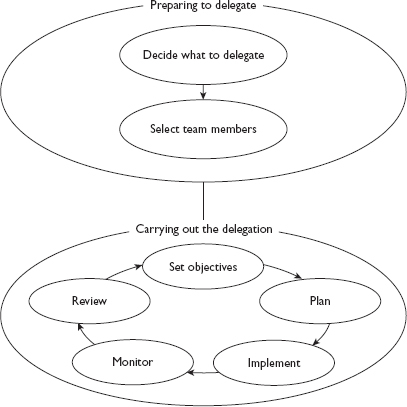Session D
Carrying out delegation
 1 Introduction
1 Introduction
You have begun the process of delegating effectively by selecting an appropriate job to delegate and by choosing a member of your workteam to carry it out. In this session you will continue the process by carrying out the delegation. This involves:
![]() setting clear objectives;
setting clear objectives;
![]() planning the delegated task;
planning the delegated task;
![]() monitoring the task when it is being carried out;
monitoring the task when it is being carried out;
![]() reviewing the results of the delegation with the team member.
reviewing the results of the delegation with the team member.
You may recall that we introduced the full process in Session A.

 2 Setting objectives
2 Setting objectives
As we saw in Session A, everyone in an organization needs to know their particular objectives – so they know where they are heading. Clear objectives allow everyone to:
![]() know precisely what has to be done;
know precisely what has to be done;
![]() judge when it has been achieved.
judge when it has been achieved.
So when you are delegating you need to write down objectives that the person who is carrying out the task can understand and use.
An effective objective is SMART. This stands for the following.
![]() Specific – stating exactly what has to be achieved, although not how the job should be done.
Specific – stating exactly what has to be achieved, although not how the job should be done.
![]() Measurable – so that you can tell when the task has been done properly; it might involve a description of the results of the task, or standards for doing the job.
Measurable – so that you can tell when the task has been done properly; it might involve a description of the results of the task, or standards for doing the job.
![]() Achievable – the objective has to be realistic in the circumstances, given the resources that are available, for example, people, equipment, materials, money, information and time, and the people who will carry it out must agree to it.
Achievable – the objective has to be realistic in the circumstances, given the resources that are available, for example, people, equipment, materials, money, information and time, and the people who will carry it out must agree to it.
![]() Relevant – the objective must be seen as relating both to the job roles of those who are to achieve the objective and to the wider objectives of the organization.
Relevant – the objective must be seen as relating both to the job roles of those who are to achieve the objective and to the wider objectives of the organization.
![]() Time bound – it is important to give some guidance about deadlines and time-frames for achieving the objective, again, these should be realistic.
Time bound – it is important to give some guidance about deadlines and time-frames for achieving the objective, again, these should be realistic.
It should also contribute to the objectives of the team or section.
So in order to write SMART objectives you need to know exactly what it is you want done, what resources will be needed to do the job and when it is to be done.
Activity 32 |
 |
Imagine you have been given the following set of objectives.
‘The job involves finding out about customer complaints in this section.
At the end of this task you will have:
![]() collected information about customer complaints between April last year and end March this year – using data stored in the customer complaints file in Jackie's office area;
collected information about customer complaints between April last year and end March this year – using data stored in the customer complaints file in Jackie's office area;
![]() organized and summarized that information;
organized and summarized that information;
![]() presented findings to the supervisor in a short (3–4 page) report in hard copy and in Word, using tables or charts to summarize the information.’
presented findings to the supervisor in a short (3–4 page) report in hard copy and in Word, using tables or charts to summarize the information.’
How SMART are these objectives? What additional information, if any, is needed to make the objectives SMART? Write your ideas below under the following headings.
Specific.
Measurable.
Achievable.
Relevant.
You probably agree that the objectives do not meet the SMART criteria. Although we know the period to be investigated, the objectives do not specify which customer complaints should be examined and they do not state what sort of information is needed. There are no details about how to organize the information, for example, does it need to be organized by type of customer, type of complaint or response to the complaint? We have more details about handing the information to the supervisor, but there is no time guideline, so we don't know when the job has to be completed. There is some indication of resources in the mention of the customer complaints file, and we will need to make sure we will have access to Word on computer in order to write the report. The vague wording of the objectives will make it difficult to know when they have been achieved, although the presentation of the report is one indication.
Before we could agree to these objectives, some important details will have to be sorted out.
To make the objectives SMART they could be refined as follows.
‘Senior management have asked for a report about how well the customer care policy is working. To do this we need to find out how we have handled all customer complaints over the past year.
Your job is to:
![]() collect information about all customer complaints between April last year and end March this year – using data stored in the customer complaints file held in Jackie's office area;
collect information about all customer complaints between April last year and end March this year – using data stored in the customer complaints file held in Jackie's office area;
![]() organize and summarize that information under the following headings:
organize and summarize that information under the following headings:
– type of customer;
– nature of the complaint;
– how the complaint was made;
– who handled the complaint;
– how the complaint was dealt with;
– response times;
– present findings to the supervisor in a short (3–4 page) report in hard copy and on disk in the normal program (Word), using tables or charts to summarize the information.
The deadline for this job is 15 May.’
Notice that the objectives here include a brief statement about why it is necessary. While it could be argued that the purpose of a job is not strictly part of the objectives, it certainly helps people if they understand why they are going to do it. Look at the following case.
Rebecca Davis was about to rush off to a meeting with clients, but she had time for a quick word with Steve Gould first. ‘Look, I have to go, but I've just heard from the warehouse that the printers have finally delivered the brochures. Can you arrange to have them transferred over here by 2.30 p.m. at the latest?’ Steve agreed and Rebecca disappeared out of the room. Steve arranged for the warehouse to interrupt another job and deliver the 10,000 brochures to reception by 2.00 p.m. At 2.40 p.m. Rebecca came out of her meeting and found Steve. ‘Where are the brochures?’ Steve explained that they were all down in reception. Rebecca pulled a face. ‘But I only need two or three of them to show to the clients.’
Just a simple misunderstanding, perhaps. But if Rebecca had explained why she needed the brochures, then she would have saved herself some embarrassment, and she would have saved Steve and the warehouse some valuable time.
Activity 33 |
 |
Check whether your objectives are linked to the work of your team and that they are:
![]() specific – so that the task is clearly defined and explained;
specific – so that the task is clearly defined and explained;
![]() measurable – so that the team member can tell when he or she has successfully achieved the task;
measurable – so that the team member can tell when he or she has successfully achieved the task;
![]() achievable – the resources required are available;
achievable – the resources required are available;
![]() relevant – everyone involved is clear why they're being asked to do the task;
relevant – everyone involved is clear why they're being asked to do the task;
![]() time bound – there is a clear deadline for completion of the task.
time bound – there is a clear deadline for completion of the task.
Be prepared to improve your objectives. You may find it helpful to put yourself in the shoes of the person to whom you will be delegating. Will the team member understand exactly what is required in doing the job when he or she reads them?
 3 Planning
3 Planning
When you have set the objectives you need to give further consideration to the task you are delegating and then discuss it with the team member. In this section we look at:
![]() planning resources;
planning resources;
![]() briefing the team member.
briefing the team member.
3.1Planning resources
When you are delegating you need to give the team member the necessary authority and resources to carry out the task.
Consider how you will make sure that the team member has the necessary authority to carry out the task, particularly where this involves other people. You may have to inform others that the team member will be acting on your behalf. Other people are just one of the resources that may be required to do the job. How will you make sure that the resources needed are available? For example, do you need to give the team member a budget to work with?
Activity 34

 |
This Activity is the sixth in a series of eleven Activities for which your responses may together form the basis of evidence for your S/NVQ portfolio. If you are intending to take this course of action, it might be better to write your answers on separate sheets of paper. In Activity 33 you developed objectives for the task you are planning to delegate. Now consider the resources you need to allocate to your team member. Make a note of these resources in the left-hand column. In the right-hand column write any action you need to take to make sure these resources are available. |
Resources needed |
How to make them available |
_________________________ _________________________ | |
_________________________ _________________________ | |
_________________________ _________________________ | |
_________________________ _________________________ | |
_________________________ _________________________ | |
_________________________ _________________________ | |
_________________________ _________________________ | |
_________________________ _________________________ | |
You may have considered the following resources:
![]() people;
people;
![]() machinery and equipment;
machinery and equipment;
![]() materials;
materials;
![]() finance;
finance;
![]() information;
information;
![]() time.
time.
As we have seen, you keep overall responsibility for the task you are delegating, so it is up to you to make sure the task is completed successfully and all the objectives are achieved. Plan to monitor the important parts of the job while it is underway. You may want to monitor the use of resources, as well as the way the job is done.
You should also plan to review it when it is completed. Consider suitable rewards for work that is done well. These can be of many different forms, such as praise, greater work independence, or maybe something tangible, such as a bonus or promotion.
We will look at monitoring and reviewing in more detail later in this session, but you do have to think about these aspects while you are planning.
3.2Briefing the team member
| EXTENSION 1 Extension 1 looks at effective communications and at making the most of meetings. |
Briefing the team member about the task is an opportunity to refine the plan and amend it where necessary. Bear in mind that you are not simply informing a team member about the task. You want to give this person responsibility to do the job so you want to gain their interest, involvement and commitment. The aim of the discussion is to reach agreement on all aspects of the task. |
| Look on the briefing as an opportunity to consult rather than simply to inform | The best way of doing this is to ask them for their views, and to be prepared to modify your ideas in the light of their contribution. Use the briefing as an opportunity to develop the plan with the team member. Remember that the team member is going to carry out the work, so they need to be comfortable with it. |
Here is a suggested approach to briefing.
![]() Explain the task and what you want to achieve. You may want to explain that you see it as a development opportunity for the team member, or that you are delegating the job to the team member because you know they have the skills, experience and expertise to do a good job.
Explain the task and what you want to achieve. You may want to explain that you see it as a development opportunity for the team member, or that you are delegating the job to the team member because you know they have the skills, experience and expertise to do a good job.
![]() Ask the team member to tell you how they would do the job, rather than instructing them how to do it. In this way you will get a clear idea about the team member's approach and can judge whether your plan for controlling the job is pitched at the right level.
Ask the team member to tell you how they would do the job, rather than instructing them how to do it. In this way you will get a clear idea about the team member's approach and can judge whether your plan for controlling the job is pitched at the right level.
![]() Ask the team member to decide what resources they think they will need to meet the objectives for the job, including any help they will need from you. Then discuss your views on resources and how you will make them available.
Ask the team member to decide what resources they think they will need to meet the objectives for the job, including any help they will need from you. Then discuss your views on resources and how you will make them available.
![]() Ask the team member to estimate the time it is likely to take. Then discuss with them your views on the timing, interim deadlines and so on.
Ask the team member to estimate the time it is likely to take. Then discuss with them your views on the timing, interim deadlines and so on.
![]() Agree how you will keep track of progress and offer support and guidance, so that the team member can come to you to discuss any ideas or problems they have.
Agree how you will keep track of progress and offer support and guidance, so that the team member can come to you to discuss any ideas or problems they have.
It is important to give the team member enough time to reflect and consider how they will do the job. Bear in mind that although you are familiar with the task, it is all new to the team member. You may need to schedule a follow-up meeting so the team member can come back to you with their thoughts and suggestions on how they will carry out the job.
Activity 35 |
 |
 |
This Activity is the seventh in a series of eleven Activities for which your responses may together form the basis of evidence for your S/NVQ portfolio. If you are intending to take this course of action, it might be better to write your answers on separate sheets of paper. Write out a checklist or briefing document for delegating on which both you and the team member can record the agreed details of the task. The document should cover all the areas you need to consider when discussing the task with the team member. |
Check that your document includes headings and space for the following information.
![]() The purpose of the task.
The purpose of the task.
![]() The objectives.
The objectives.
![]() The resources available.
The resources available.
![]() The support available.
The support available.
![]() How to monitor the task and keep track of progress.
How to monitor the task and keep track of progress.
![]() When and how you will review the task.
When and how you will review the task.
Activity 36 |
 |
 |
This Activity is the eighth in a series of eleven Activities for which your responses may together form the basis of evidence for your S/NVQ portfolio. If you are intending to take this course of action, it might be better to write your answers on separate sheets of paper. Use your checklist to brief your team member on the task you have chosen to delegate. Now make brief notes on how well the briefing went by answering the following questions. |
How well did you describe the background and purpose of the job?
How did you explain why you have selected the team member to do the job?
How well did you talk through with the team member:
![]() the objectives?
the objectives?
![]() the resource requirements?
the resource requirements?
![]() how you and others can provide support?
how you and others can provide support?
![]() how to monitor progress?
how to monitor progress?
![]() how to review the task?
how to review the task?
What contributions did the team member make to the discussion?
How would you describe the team member's attitude towards the task? (Committed, enthusiastic, confident, apprehensive?)
How successful was the briefing?
What will you do next time to improve the briefing?
A successful briefing depends on good planning and effective communication on the part of the manager. This means listening carefully, responding appropriately and checking understanding. Remember that a successful briefing will lead to agreement about the task. You will feel confident that the job you have delegated is in good hands, and that the team member knows what to do, how to do it, by when and with what results. You will also feel that the team member is committed to doing the job well.
After the briefing the team member should begin to carry out the job. Although you have handed over the job you will still need to check on progress through monitoring.
 4 Monitoring the delegated task
4 Monitoring the delegated task
By monitoring a job, you stay in control, you will be able to see potential problems at an early stage and you can guide your team member to make any necessary changes to keep the job on course.
Remember that the level of direct control you have over a job is related to the amount of trust you have in the team member doing a good job. Bear in mind how the team member is likely to respond if you show little confidence in their abilities and keep intervening in the job. Whenever you delegate, you are taking some risk, because you are sharing your responsibility for the job with another person.
The key to monitoring work that you delegate is to agree the following with the team member at the start.
![]() Objectives – what you want to achieve.
Objectives – what you want to achieve.
![]() Time scales and deadlines – what aspects of the job need to be completed by when.
Time scales and deadlines – what aspects of the job need to be completed by when.
![]() Critical activities – the key parts of a job, on which the success of the whole job depends.
Critical activities – the key parts of a job, on which the success of the whole job depends.
You can then agree to monitor the job against these benchmarks. There are many ways of monitoring, as shown below.
![]() Having informal discussions with a team member when you meet him or her on-the-job.
Having informal discussions with a team member when you meet him or her on-the-job.
![]() Collecting information, such as operating temperatures of machinery, attendance records, numbers of telephone calls made, number of client contacts made.
Collecting information, such as operating temperatures of machinery, attendance records, numbers of telephone calls made, number of client contacts made.
![]() Arranging to review progress with the team member perhaps by a report or an informal meeting. Progress reviews may be planned in advance and determined by time, stages in the job or other factors.
Arranging to review progress with the team member perhaps by a report or an informal meeting. Progress reviews may be planned in advance and determined by time, stages in the job or other factors.
![]() Agreeing with a team member that they will come to you if they predict any problems or difficulties in getting the job done as previously agreed.
Agreeing with a team member that they will come to you if they predict any problems or difficulties in getting the job done as previously agreed.
![]() Examining the results of work – a manufactured product, a report, etc.
Examining the results of work – a manufactured product, a report, etc.
![]() Observing a team member carrying out some aspect of the job, a discussion with a customer or colleague, for example.
Observing a team member carrying out some aspect of the job, a discussion with a customer or colleague, for example.
Team members are usually actively involved in collecting, recording and communicating information for monitoring. Although this information may come to you so that you can keep overall control of the work, team members themselves often know when the work is going well and when a job is going off-course. They can usually suggest solutions, if encouraged to do so.
By getting team members to monitor aspects of a task themselves, you are giving them scope to control the work, to take appropriate action if they foresee any problems. This shows that you trust them.
If you uncover a potential problem while monitoring the delegated task, be tactful in pointing it out to the team member, for example, choose a quiet place where you won't be overheard. Encourage the team member to offer solutions. Bear in mind that your aim is to support the team member and help him or her be successful.
Activity 37 |
 |
 |
This Activity is the ninth in a series of eleven Activities for which your responses may together form the basis of evidence for your S/NVQ portfolio. If you are intending to take this course of action, it might be better to write your answers on separate sheets of paper. |
What methods are you using to monitor the job you have delegated?
How involved is the team member in monitoring?
Think about the level of direct control you have over the task, and the level of trust this shows that you have in your team member.
Mark the spectrum below to indicate your level of control and trust.
high control |
low control |
low trust |
high trust |
It is worth thinking about whether you have chosen an appropriate level of control and trust. You can do this when you come to review the delegated task.
 5 Reviewing the delegation
5 Reviewing the delegation
Although you may review progress while the job is underway, you will want to carry out a thorough review soon after a delegated task has been completed. It is an important opportunity for you and your team member to consider the success – or otherwise – of the task, to learn from the experience and plan improvements for the future.
Your review may cover different aspects of the task, including the process of delegating. For example, you may want to look at:
![]() the extent to which the objectives have been met or have had to be changed;
the extent to which the objectives have been met or have had to be changed;
![]() the use made of resources;
the use made of resources;
![]() the effectiveness of support given to the team member;
the effectiveness of support given to the team member;
![]() how well the task was monitored and controlled;
how well the task was monitored and controlled;
![]() any difficulties or problems;
any difficulties or problems;
![]() the team member's performance in carrying out the job and how he or she can build on what has been learned.
the team member's performance in carrying out the job and how he or she can build on what has been learned.
When reviewing a delegated task, it is best to let your team member get the praise for work successfully done, but to accept the blame yourself when things have gone wrong. The reason for this is that you have to accept overall responsibility, including the decision to delegate in the first place.
An important part of any review will be the feedback that you give to the team member on their performance.
Activity 38

Note down what you think is the purpose of giving feedback to a team member about their performance in carrying out a delegated task.
I hope you agree that the aim of giving feedback is to help the team member learn from the experience – both the successes and failures – so that they can do better next time. It is the key to encouraging staff to develop, so it is an important part of your responsibilities as a manager.
Feedback should be designed to improve performance.
As a team leader you will probably give informal feedback to team members frequently, but it is also important to set aside some time to have a one-toone meeting with the team member to give formal feedback.
Giving feedback on good performance does not usually represent a problem – as long as you still do give feedback. Successful people need as much development as unsuccessful ones. Feedback on good performance should encourage team members to reflect, identify what has contributed to their success, and consider what they would do differently next time.
When we have to point out mistakes and poor performance we have to work hard to avoid criticizing. Think about how you react when someone criticizes you. Most people agree that if they feel they are being criticized, they get upset or resentful, make excuses or stop listening.
If feedback makes someone feel bad or useless, then it has not served its purpose. Even if you have to point out mistakes, it is important that what you say is encouraging and designed to increase motivation.
Here are eight simple guidelines for giving effective feedback.
1 Never give feedback when you are angry or frustrated. You need to be calm, thinking about solving any problem and moving forward.
2 Give praise where it is due. It is all too easy to forget the aspects of a job that have been done well, especially when there are other problems. Be specific in your praise, highlighting those aspects of a job that were handled well, or where the team member showed good judgement.
3 Encourage the person to whom you are giving feedback to contribute their ideas. These might include what they think they did well, what went wrong and why, and how they would do things next time. By getting the person to assess their own performance you will have a clear idea of areas of agreement, and areas where you need to give more guidance about mistakes.
4 Be specific about mistakes. Give exact instances so that the other person can recognize where mistakes were made.
5 Criticize the action or the behaviour, not the person. For example, don't say, ‘You were wrong to …’, instead say that a particular action was wrong.
6 Investigate the cause of any difficulty. Was it an instance of bad judgement, was it to do with lack of resources, was it owing to lack of support from you?
7 Offer support. How can you help the person solve the problem for the future? Does the person need training? Do they need more support from you or from a team member?
8 End on a positive note by looking forward to making improvements next time around. Looking ahead enables both you and the person to whom you are giving feedback to put any mistakes of the past to rest, and move forward.
This kind of feedback is an important aspect of your responsibilities for the development of staff. It doesn't cost anything, except your time, but it's this kind of attention which can make a real difference to people's careers and commitment.
Activity 39 |
 |
 |
This Activity is the tenth in a series of eleven Activities for which your responses may together form the basis of evidence for your S/NVQ portfolio. If you are intending to take this course of action, it might be better to write your answers on separate sheets of paper. |
Plan a feedback session with your team member to review his or her performance in carrying out the delegated task.
When is the review session?
What did the team member do well?
What mistakes were made?
Why do you think mistakes were made?
What suggestions do you have for making improvements in the future?
What are the next steps for the team member, for instance, more responsibility and involvement in the team, some coaching, a training course?
You may ask the team member to plan for the session in a similar way, by considering what went well, where improvements could be made next time and so on. Your team member's self-assessment is important, and you could use it as evidence in your portfolio.
Use your plan to carry out the feedback session. Then assess how well it went in the next activity.
Activity 40 |
 |
 |
This Activity is the last in a series of eleven Activities for which your responses may together form the basis of evidence for your S/NVQ portfolio. If you are intending to take this course of action, it might be better to write your answers on separate sheets of paper. |
Assess your feedback session by answering the following questions.
What aspects of the feedback session went well? Why?
What aspects of the session could have gone better? Why?
What contribution did the team member make to the session?
How did the team member feel about the feedback you gave? For example, were you able to agree about his or her performance? Did you agree on the next steps?
What will you do differently the next time you give feedback?
Giving constructive feedback is not easy, and it takes practice to give feedback which helps team members improve performance. If you have identified areas for improvement, you are working towards developing your feedback skills.
To delegate effectively you need to use a range of management skills: planning, organizing, communicating, briefing, supporting, controlling and giving feedback.
Delegating will give you more time to concentrate on your important work, but, more significantly perhaps, by using the process of delegating and delegating effectively, you will also develop your team and your relationship of trust with team members.
Self-assessment 4 |
 |
1 Describe the features of a SMART objective.
S____________________________________________________
M____________________________________________________
A____________________________________________________
R____________________________________________________
T____________________________________________________
For questions 2 to 5, complete the sentences with a suitable word or words.
2 When briefing a team member make sure that you and they ______________all aspects of the task.
3 ______________ involves collecting information about how well a task is going, and enables you or the team member to take action to prevent problems from becoming serious.
4 After the delegated task has been done, you should ______________its successes and failures, so that you can make improvements next time.
5 Part of a review involves giving ______________ to the team member on his or her performance.
6 Complete the eight guidelines for giving constructive feedback listed below.
a Never give feedback when you are ______________.
b Give ______________ where it is due.
c Encourage the person to whom you are giving feedback to ______________.
d Be specific about ______________.
e Criticize the ______________, not the person.
f Investigate the ______________ of any difficulty.
g Offer ______________.
h End on ______________.
Answers to these questions can be found on page 105.
6 Summary
![]() Objectives state what you want to achieve.
Objectives state what you want to achieve.
![]() Objectives should be SMART.
Objectives should be SMART.
![]() Specific.
Specific.
![]() Measurable.
Measurable.
![]() Achievable.
Achievable.
![]() Relevant.
Relevant.
![]() Time bound.
Time bound.
![]() When planning the delegation, make sure that:
When planning the delegation, make sure that:
![]() the necessary authority for carrying out the task is given;
the necessary authority for carrying out the task is given;
![]() the necessary resources are made available.
the necessary resources are made available.
![]() The purpose of briefing a team member when delegating to them is to reach agreement about all aspects of the task, including the objectives and to gain their commitment to do the task.
The purpose of briefing a team member when delegating to them is to reach agreement about all aspects of the task, including the objectives and to gain their commitment to do the task.
![]() When discussing the task ask the team member how they would do it, what resources they think they would need, and so on, and then discuss your views.
When discussing the task ask the team member how they would do it, what resources they think they would need, and so on, and then discuss your views.
![]() Monitoring enables you to keep track of progress and take action to keep a job on course if there are problems.
Monitoring enables you to keep track of progress and take action to keep a job on course if there are problems.
![]() You can use formal and informal methods to monitor a delegated task and encourage team members to take part in monitoring.
You can use formal and informal methods to monitor a delegated task and encourage team members to take part in monitoring.
![]() Make sure you are available to offer support to the team member when needed.
Make sure you are available to offer support to the team member when needed.
![]() Your review of the delegation when the task is completed should include giving feedback on the team member's performance.
Your review of the delegation when the task is completed should include giving feedback on the team member's performance.
![]() Giving feedback is an important part of your responsibility to develop staff.
Giving feedback is an important part of your responsibility to develop staff.
![]() Give feedback sensitively in order to help the team member improve his or her performance in the future.
Give feedback sensitively in order to help the team member improve his or her performance in the future.

